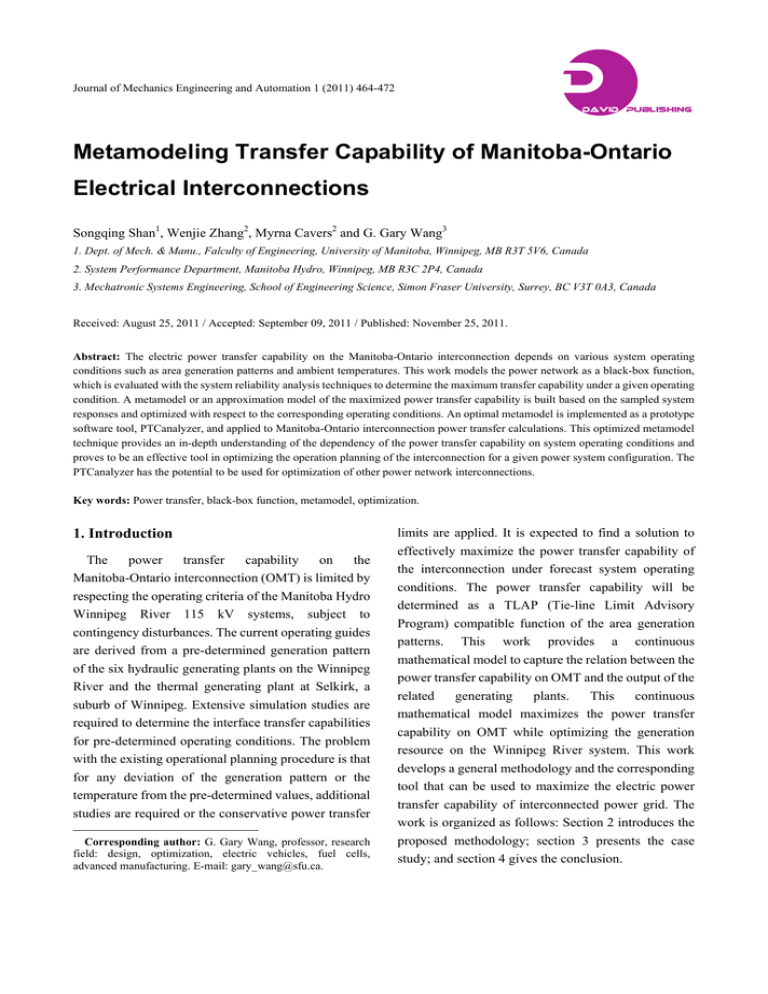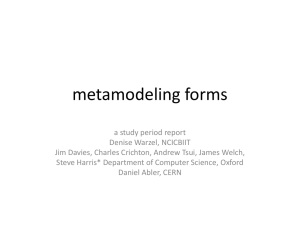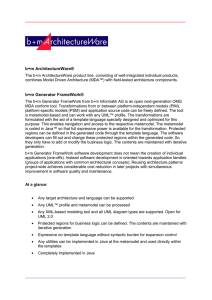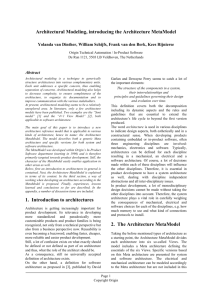D Metamodeling Transfer Capability of Manitoba-Ontario Electrical Interconnections Songqing Shan
advertisement

D Journal of Mechanics Engineering and Automation 1 (2011) 464-472 DAVID PUBLISHING Metamodeling Transfer Capability of Manitoba-Ontario Electrical Interconnections Songqing Shan1, Wenjie Zhang2, Myrna Cavers2 and G. Gary Wang3 1. Dept. of Mech. & Manu., Falculty of Engineering, University of Manitoba, Winnipeg, MB R3T 5V6, Canada 2. System Performance Department, Manitoba Hydro, Winnipeg, MB R3C 2P4, Canada 3. Mechatronic Systems Engineering, School of Engineering Science, Simon Fraser University, Surrey, BC V3T 0A3, Canada Received: August 25, 2011 / Accepted: September 09, 2011 / Published: November 25, 2011. Abstract: The electric power transfer capability on the Manitoba-Ontario interconnection depends on various system operating conditions such as area generation patterns and ambient temperatures. This work models the power network as a black-box function, which is evaluated with the system reliability analysis techniques to determine the maximum transfer capability under a given operating condition. A metamodel or an approximation model of the maximized power transfer capability is built based on the sampled system responses and optimized with respect to the corresponding operating conditions. An optimal metamodel is implemented as a prototype software tool, PTCanalyzer, and applied to Manitoba-Ontario interconnection power transfer calculations. This optimized metamodel technique provides an in-depth understanding of the dependency of the power transfer capability on system operating conditions and proves to be an effective tool in optimizing the operation planning of the interconnection for a given power system configuration. The PTCanalyzer has the potential to be used for optimization of other power network interconnections. Key words: Power transfer, black-box function, metamodel, optimization. 1. Introduction The power transfer capability on the Manitoba-Ontario interconnection (OMT) is limited by respecting the operating criteria of the Manitoba Hydro Winnipeg River 115 kV systems, subject to contingency disturbances. The current operating guides are derived from a pre-determined generation pattern of the six hydraulic generating plants on the Winnipeg River and the thermal generating plant at Selkirk, a suburb of Winnipeg. Extensive simulation studies are required to determine the interface transfer capabilities for pre-determined operating conditions. The problem with the existing operational planning procedure is that for any deviation of the generation pattern or the temperature from the pre-determined values, additional studies are required or the conservative power transfer Corresponding author: G. Gary Wang, professor, research field: design, optimization, electric vehicles, fuel cells, advanced manufacturing. E-mail: gary_wang@sfu.ca. limits are applied. It is expected to find a solution to effectively maximize the power transfer capability of the interconnection under forecast system operating conditions. The power transfer capability will be determined as a TLAP (Tie-line Limit Advisory Program) compatible function of the area generation patterns. This work provides a continuous mathematical model to capture the relation between the power transfer capability on OMT and the output of the related generating plants. This continuous mathematical model maximizes the power transfer capability on OMT while optimizing the generation resource on the Winnipeg River system. This work develops a general methodology and the corresponding tool that can be used to maximize the electric power transfer capability of interconnected power grid. The work is organized as follows: Section 2 introduces the proposed methodology; section 3 presents the case study; and section 4 gives the conclusion. Metamodeling Transfer Capability of Manitoba-Ontario Electrical Interconnections 2. Proposed Methodology a xb otherwise (1) X The corresponding uniform Cumulative Density Function (CDF) is xa 0 x a F ( x) a xb (2) b a 1 bx In this project, it is assumed that the generation patterns are of the uniform distribution. 2.1.2 Mathematical Model There are a number of widely used metamodels such as polynomials, Radial Basis Functions (RBF), Artificial Neural Network (ANN), and Kriging model. Among these models, the polynomial model is robust, simple-to-implement, and easy to interpret and understand. This project therefore adopts the polynomial metamodel, which is in the form of Ref. [1]. β ε (3) where is an n 1 matrix and represents sampled is an n p matrix, representing n number responses; f The transfer capability over a power network is determined by computer simulations, the process of which is considered in the study as a so-called black-box function. For optimization of black-box problems, a widely-used approach is using sampling and modeling techniques to build a metamodel, on which optimization is performed [1]. This section introduces related sampling, optimization, and 1 f ( x) b a 0 X 2.1 Related Theories metamodeling theories. 2.1.1 Sampling In this work, we use the term “sampling” to refer to the computer experimental design, which is widely used to build surrogate models or metamodels. Wang and Shan [2] reviewed the techniques of the computer experimental design. This work uses uniformly distributed random sampling to sample the inputs. The uniform distribution has a constant Probability Density Function (PDF) between its two bounded parameters (a, b) as follows [3]: f This study proposes the use of metamodeling to build a mathematical model of the maximized transfer capability of interconnected power grid. The metamodeling approach literally means the “model of model”. It starts with systematically planned samples, or “experiments”. Each sample is an assumed combination of all the related factors. These factors will be used as inputs to the system model, on which various analyses are performed. The output will be the feasibility of the sample point and the values of the interested factors. For example, if the transfer capability is of interest, generation patterns may become the input factors. Given a set of values of these input factors, system models are called to test feasibility of such a combination. If it is feasible, the analysis should determine the maximum possible value for the transfer capability. Once all the samples have been evaluated, a metamodel can be built for the transfer capability as a function of the input factors. After validation, the metamodel can be used to schedule and plan the interchange across the interconnections depending on the real time values of the input factors. Generally speaking, this project applies sampling, optimization, and metamodeling techniques to build a mathematical model of the transfer capability, which will be implemented as a TLAP compatible function. This model provides a solution to effectively maximize the transfer capability of the interconnection under forecast system operating conditions. 465 of sample points of p predictor variables. The predictor variables include input variables, quadratic terms of the variables, or combinations of variables;β is a p 1 ε matrix of regression coefficients; and is an n 1 matrix and represents random disturbances. The performance and response of a power network can be modeled and evaluated by the PSS/ETM power system simulation program coded by IPLAN language [4]. Given a system operating condition such as a Metamodeling Transfer Capability of Manitoba-Ontario Electrical Interconnections 466 . The residuals are the difference between the sampled value predicted value ˆ . ˆ( ) and the f H I bl x l is called the hat matrix f because it puts the “hat” on (6) The residuals are useful for detecting failures in the model assumptions since they correspond to the ε in the model Eq. (3). By assumption, these errors ε have independent normal distributions with errors zero mean value and a constant variance. The residuals, however, are correlated and have variances that depend on the locations of the data points. It is a common practice to scale the residuals so they all have the same variance. By scaling the residuals, a confidence interval for the means of each error can be obtained as where K 0.618 and I bu bl . (3) Perform black-box function analysis and decide on the next interval for further search. Evaluate xu If xu meets operating criteria, set b l x u Else Evaluate xl If xl meets operating criteria, set T f x1 bu KI xu bl KI X function is to be performed. f H and define the two points, at which the black-box f f r (2) Break up the searching range into three intervals T X tolerance (for example 10 MW). (5) 1 f Section method are as follows: (1) Specify bl and bu and set K 0.618 and where X X trial values of f, which will be evaluated against contingency conditions to ensure such a value is achievable and feasible. Then a new trial value of f is generated until the maximum f max is obtained. The steps for searching f max based on the 1-D Golden b X f dimensional search process. In specific, given a search range for f max in [bl,bu ] , the process starts from ˆ H generation pattern, the maximum power transfer capability, f max can be determined through a one ci ri t 1 ,i ˆ i 1 hi (7) 2 where ci is the confidence interval for the means of the i-th error; ri is the raw residual for the i-th data point; t i is the scaled residual for the i-th data point; ˆ (i ) is the estimate of the variance of the errors H excluding the i-th data point from the calculation, and hi is the i-th diagonal element of . bu xu Else bu xl (4) Check whether a satisfactory level of tolerance is fX reached. If bu bl , return to Step 2. (5) Maximum transfer is obtained as f max bu . b is the vector of For the problem in Eq. (3), f max ' s for each given input vector . The solution to ,b p , where , p as T ] , pb p b b . . . ,2 ,1 T ] [ at the data points . . . ,2 ,1 [ the predicted values f back into the model formula to get 2 (4) . . . ,2 1 T re-write b b ,1 f X T X b Substituting X b β ˆ 1 [ solution is confidence intervals help to identify outlier observations for a given model. 2.1.3 Metamodel Optimization A good metamodel should objectively reflect the black-box function, being both accurate and simple. In order to get such an optimal metamodel, the metamodel is optimized to best fit the data points. We T b ] the problem is the vector, , which estimates the unknown vector of parameterβ . The least square Confidence intervals that do not include zero are equivalent to rejecting the hypothesis that the residual mean is zero at a significance probability of . Such with γi = 0 or 1. By various combination of the components of , the predictor variable terms of the Metamodeling Transfer Capability of Manitoba-Ontario Electrical Interconnections 467 X f ︶ n / ︶ ︵* (8) b X f ( ˆ) T * ( ˆ) / n T ︵ * /n f b r f X rmse f f T r metamodel or the column of can be selected and the metamodel optimized. According to Eq. (6), the root mean squared errors (RMSE) are given as and the optimal metamodel can be obtained by solving the following combinatorial integer optimization problem. min rmse (9) s.t. γi ( 0 or 1 ) X We simplify this optimization by the following steps: (1) Transform the components of data points (the partial components of ) into a common range [-1, 1]. (2) Build a metamodel and find . (3) Set the small value components of as zero b b b and build a new metamodel. In this work, we set the to be zero if the value of components of component’s value is less than one. (4) Observe the new value of rmse. If the new rmse value is acceptable, the optimal metamodel is obtained. Otherwise, a metamodel with a smaller rmse value is selected. metamodel optimization is for model building and the optimal model selection. The procedures as illustrated in Fig. 1 are explained here in some detail. Step 1: Initial sampling In this project, the sampling function “RAND” in MatlabTM is used to sample the generation patterns and ambient temperatures. The number of sampling data points is n (nv 1) * (nv 2) / 2 , where nv represents the number of the generation plants plus one ambient temperature variable. By assuming the uniform distribution of the generation patterns and temperature, the proposed method and associated tool, PTCanalyzer, automatically samples the multiple generation patterns and temperature within the given lower and upper limits of each variable. This sampled data is sequentially fed into PSS/ETM for power network simulations coded by IPLAN language [4]. Step 2: Black-box function evaluation This step includes the power network system simulation to determine the transfer limits. PTCanalyzer automatically starts the PSS/ETM and loads Start Initial sampling Black-box function evaluation 2.2 Implementation and Convergence Criteria Based on the above black-box function realization and related theories, this section describes the implementation procedures and metamodeling convergence criteria. 2.2.1 Implementation Procedures The implementation procedure for the entire metamodeling process includes three main components, sampling, black-box function evaluation, and metamodeling/optimization. The purpose of sampling simulates the inputs, i.e., the generation patterns and ambient temperature. The black-box function evaluation simulates the power network responses and determines its maximum transfer capability for the given generation pattern. Metamodeling and Metamodeling Model Validation N Converged? Y Metamodel optimization Output Stop Fig. 1 Optimal metamodeling flowchart. 468 Metamodeling Transfer Capability of Manitoba-Ontario Electrical Interconnections in an initial base case representing a specified operating condition. For each combination of generation patterns and temperature, PSS/ETM performs the contingency analysis and the results are automatically sorted and searched for criteria violations and a maximum transfer level is found. Step 3: Metamodeling Once the transfer limits for the sampled generation patterns and temperatures are obtained, the remaining task is metamodeling. In the previous section, a general mathematical model Eq. (3) is introduced and it can have different types such as linear, pure quadratic, and so on. In this project, a full quadratic model is proposed based on the fact that a full quadratic model suits better It can be optimized to become a model most suitable to a specific application by removing terms from the full quadratic model. Step 4: Model validation Model validation includes re-sampling nv data points as in Step 1, performing black-box function the black-box function and metamodel prediction at test points. The comparison result is checked against new the metamodel. The true response values, new , are w e fn w e fn w e fn obtained by calling the black-box function. The relative errors are calculated by ( ˆ )/ (10) er The maximum absolute relative error is ermax max er one of the two convergence criteria as discussed below. Step 5: Convergence check This step checks whether convergence criteria are met. If the convergence criteria are not met, the new nv sampling data points from Step 4 are added to the previous modeling data set and the process goes back to Step 3. Step 6: Metamodel optimization A full quadratic model is a fixed model, and is to be optimized into a more succinct and accurate model by using the methodology as described in the previous section. Step 7: Result output The result output includes two categories. One is the f predicted values at test points, and comparing values of The metamodel is called to predict values of the black-box function on the new sample point set. In the model validation step (Step 4), after sampling a new data set, the predicted values, ˆ , are obtained from f analysis as in Step 2, evaluating metamodel to give b linear, pure quadratic, and two-factor interaction terms. b degree of flexibility. A full quadratic model covers all b for the application. It is simple and offers a certain parameter output. The other is the graphic output. The parameter output includes the optimal metamodel, root mean squared error, number of black-box function evaluations, and number of iterations. The graphic output includes a prediction plot of the metamodel, the metamodel coefficients and their 95% confidence intervals, a plot of residual vs. predicted values, as well as residuals and their 95% confidence intervals. 2.2.2 Convergence Criteria This work applies two convergence criteria. The first criterion is the change of the metamodel coefficients. As the coefficients define a polynomial metamodel, if the change of the coefficients between iterations is small, it means that the metamodel is stable. For example, the convergence criteria for the metamodeling coefficient may be specified as max i i 1 0.1 in two consecutive iterations. This criterion tests the metamodel at all evaluated sample points. The second criterion is applied for new sample points, and the number of new sample points is set to be the same as the number of initial sample points n (nv 1) * (nv 2) / 2 . (11) This work sets e rmax 0.05 (a preset value). The new sample data set will be added to existing evaluated data set, which is used to update the metamodel. Besides the above two criteria, the maximum number of iterations is also applied. If convergence criteria are met or the number of iterations reaches the maximum number, the metamodeling process terminates. 3. Case Study The proposed methodology in section 2 has been Metamodeling Transfer Capability of Manitoba-Ontario Electrical Interconnections implemented as a prototype software tool, PTCanalyzer. PTCanalyzer provides users with both graphical and numerical outputs and has been applied for modeling and calculating power transfer capability on the Manitoba-Ontario interconnected systems. Seven cases representing different operating conditions are used to test the proposed methodology with two to be described in detail in this work. 469 Pine Falls Selkirk Great Falls PDB Slave Falls MCA Rosser Seven Sisters 3.1 Case Description OMT St. Vital Fig. 2 shows a single line diagram of Winnipeg River area system and Manitoba-Ontario interconnections. The 115 kV transmission system interconnects the generating plants of the Winnipeg River, the Selkirk generating station, the Manitoba-Ontario interface, and the major 230 kV transmission grid surrounding the City of Winnipeg. There are six hydraulic generating plants on the Winnipeg River. Four plants, Seven Sisters, Great Falls, McArthur Falls, and Pine Falls, are connected through the 115 kV transmission system. The other two plants, Pointe du Bois and Slave Falls, feed radially into the City of Winnipeg 66 kV system. Selkirk generating station is a gas fired thermal plant located near the City of Winnipeg and connected to the 115 kV transmission system. The OMT consists of two 230 kV tie lines from Fig. 2 Winnipeg River area system and OMT. Table 1 Winnipeg River generation output ranges. Generation levels High Low G1 G2 G3 G4 G5 84-168 69-115 0-23 28-56 45-90 28-84 23-69 0-23 7-28 15- 45 low scenarios. The G2 and G3 are generating units at Great Falls station, which are modeled separately. Temperature is assumed at a constant 40 °C. Seven cases of different generation levels have been tested. But due to the page limitation, only two cases for high generation levels are presented in the paper. 3.2 Case 1—Import Manitoba to northwestern Ontario. The interface is The import is for power transfer west from Ontario controlled by the 115 kV phase shifting and 115/230 to Manitoba. The total generation on the four Winnipeg kV voltage regulating transformers at Whiteshell River plants varies between 333 MW and 558 MW, station near the Manitoba-Ontario border. Generation which falls into the high level generation range as listed levels of the hydraulic plants on the Winnipeg River in Table 1. For this case, the Selkirk generating units are a function of river system management and are off line. The simulation runs 30 iterations with 651 times of black-box evaluations. The rmse for this case is 3.5 and the maximum absolute residual is 23.8. Fig. 3 shows the modeling interface of PTCanalyzer. The horizontal coordinate denotes the various generating plants and their corresponding generation level ranges, respectively. The vertical coordinate denotes the transfer capability on the OMT. The “Export” button is used to select specific terms to build a simplified economic operation of the plants. The total generation levels can vary significantly from a maximum of 590 MW to minimum of 137 MW depending on the river flow. Selkirk Generating station is operated when required for system reliability. The case studies in the paper are for 2007 summer peak load with all the transmission lines in service. The Winnipeg River generation levels are listed in Table 1 where the generation levels are organized into high and 470 Metamodeling Transfer Capability of Manitoba-Ontario Electrical Interconnections Table 2 Metamodeling data for Case 1. Coefficients Model terms Fig. 3 Case 1 modeling output interface. metamodel. The users can use the pop-up menu, “user specified”, to interactively change the model between “linear”, “pure quadratic”, “interaction”, “full quadratic” and the optimal model. There is a family of curves, each showing the sensitivity of a generating plant output to the transfer capability on Manitoba Ontario interconnection. The two red dash curves show 95% global confidence intervals for the predictions. Fig. 3 visualizes the relationship between the power transfer capability on the OMT and the generation patterns of Winnipeg River generating plants. Users can drag the horizontal dashed blue reference line and watch the predicted values update simultaneously. Alternatively, users can get a specific prediction by typing the values of the generation pattern into an editable text field. For example, users can input a generation pattern, G1 = 120, G2 = 92, G3 = 11, G4 = 41, and G5 = 67, to predict the transfer capability to be 127.9138 1.2995. Other metamodeling related data are listed in Table 2, where the first column shows the model coefficients; the second column shows the terms in the optimized model, and the third column gives the 95% coefficients’ intervals for the coefficients. For this example, the value of the root mean square errors is 3.5423 and the maximum absolute residual is 23.7687. In the output model, each term has not only its physical meaning, but also some uncertainty. Fig. 4 shows the 95% confidence interval of the coefficients by the term of the coefficients on the horizontal axis. -345.2390 0.9763 0.3888 0.5094 0.6801 0.3232 0.0052 -0.0040 -0.0067 0.0018 0.0040 Constant G1 G2 G3 G4 G5 G2 * G3 G2 * G5 G3 * G5 (G2)2 (G5)2 95% Confidence Interval -365.2464 0.9651 0.0457 0.1296 0.6458 0.0399 0.0019 -0.0056 -0.0100 0.0001 0.0022 -325.2316 0.9875 0.7320 0.8892 0.7145 0.6065 0.0084 -0.0024 -0.0033 0.0035 0.0059 Fig. 4 Case 1 95% coefficient confidence intervals. Only the constant term has a bigger interval. A big interval under a fixed confidence level indicates more uncertainty. The constant term is related to the power network conditions and status. In this case, the big interval of the constant terms indicates that the big uncertainty comes from the power network, and the power transfer capability depends on the power network conditions and status. Fig. 5 displays the residuals vs. the predicted values. The general impression is that the residuals symmetrically scatter along zero with a few points scattering out, which approaches the assumption that the errors have independent normal distributions with mean zero and a constant variance. Fig. 6 plots the residuals and 95% confidence intervals for all the function evaluations. The 95% confidence intervals about these residuals are plotted as error bars. There are 4 100% 0.61% outliers since 651 their errors bar do not cross the zero reference line. Metamodeling Transfer Capability of Manitoba-Ontario Electrical Interconnections 471 Table 3 Case 1 transfer capabilities comparison. G1 168 84 Generation pattern G2 G3 G4 G5 115 23 56 90 46 23 28 45 Meta model -42.2 -125.4 Black box -47 -127 Difference 4.8 1.6 Table 4 Case 1 metamodel comparison. Pure quadratic -42 ± 5.2 -42 ± 2.5 -40 ± 4.8 -5 -5 -7 -125 ± 3.4 -124 ± 1.7 -123 ± 3.2 -2 -3 -4 Optimal Fig. 5 Case 1 residuals vs. predicted values. Linear Interactions -45 ± 8.8 -2 -125 ± 3.8 -2 Full quadratic -42 ± 10.6 -5 -124 ± 5.1 -3 3.3 Case 2—Export The second case study is for export, which is power transfer east from Manitoba to Ontario. Generation on the Winnipeg River plants varies between 333 MW and 558 MW, which falls into the high level generation range as shown in Table 1. For this case, the Selkirk generation is at 65 MW. The simulation runs 24 iterations with 525 times of black-box evaluations. The rmse for this case is 2.9 and the maximum absolute residual is 30.6. The modeling output interface is shown in Fig. 7. As can be seen, the Fig. 6 Case 1 95% Residuals confidence intervals. non-linear relationship between the input factors and Table 3 compares the power transfer capabilities determined by the optimal model from the PTCanalyzer and the conventional method, respectively, for two generation patterns and their differences. It can be seen that the derived model can accurately predict the power transfer capability. In the modeling process, users can select five different models, optimal model or specified model, linear model, pure quadratic model, interactions model and full quadratic model. Table 4 lists the various models’ results and their differences for the two generation patterns listed in Table 3. It can be seen that each model can accurately predict the power transfer capability on OMT. Among all, the optimal model yields better-than-average performance from the perspectives of both the difference between the predicted value and the actual value, as well as the variance. the output is apparent, which is in contrast to Case 1 whose relationship is mostly linear. Other metamodeling related data are listed in Table 5, in a format similar to Table 2. Table 6 lists the power transfer capabilities determined by the metamodel and the conventional method, respectively, for two generation patterns and their difference. It can be seen that the proposed model can accurately predict the power transfer capability even for non-linear relationships. Table 7 lists the various models’ results and their differences for the two generation patterns in Table 6. From the test results it is found that the optimized metamodel technique provides an in-depth understanding of the dependency of the power transfer capability on system operating conditions and proves to be an effective tool in optimizing the operation Metamodeling Transfer Capability of Manitoba-Ontario Electrical Interconnections 472 planning of the interconnection for a given power system configuration. G1 168 112 4. Conclusions This work investigates the power transfer capability on the Manitoba-Ontario Interconnection for various operating conditions by applying the metamodeling techniques. This work can enhance the understanding of the performance of Manitoba-Ontario interconnected Fig. 7 Case 2 modeling output interface. Table 5 Case 2 metamodel data. Coefficients Model terms 290.2372 0.0078 0.2068 0.0026 0.0014 0.0019 -0.0025 -0.0035 -0.0014 -0.0015 Constant G1 G2 G1 * G2 G1 * G4 G1 * G5 G2 * G4 G2 * G5 (G1)2 (G2)2 Table 6 Case 2 transfer capabilities comparison. 95% Confidence Interval 280.0010 300.4734 - 0.1247 0.1402 0.0609 0.3526 0.0021 0.0032 0.0006 0.0022 0.0014 0.0024 -0.0038 -0.0013 -0.0043 -0.0027 -0.0019 -0.0009 -0.0022 -0.0007 Generation pattern G2 G3 G4 G5 115 23 56 90 93 22 42 75 Table 7 Meta model 297.4 296.2 Black box 300 300 Difference -2.6 -3.8 Case 2 metamodel comparison. Pure Optimal Linear 297 ± 3.7 297 ± 2.5 294 ± 4.7 -3 -3 -6 296 ± 1.2 296 ± 1.4 297 ± 2.5 -4 -4 -3 Interactions Full 301 ± 7.3 299 ± 8.6 1 -1 295 ± 2.1 297 ± 3.0 -5 -3 power grid. A modeling tool, PTCanalyzer, is developed and used for power transfer capability metamodeling under varying system conditions. The optimized metamodel indicates the effects of generation stations on the transfer capability and maximizes the use of the Manitoba-Ontario Interconnections. The method and the tool are proved to be useful in operational planning of the interconnected power grid. References [1] [2] [3] [4] R.H. Mayers, D.C. Montgomery, Response Surface Methodology, John Wiley & Sons, 1995. G.G. Wang, S. Shan, Review of Metamodeling Techniques in Support of Engineering Design, Transaction of ASME, Journal of Mechanical Design 129 (4) (2007) 370-380. R. Johnson, G. Bhattacharyya, Statistics, Principles and Methods, John Wiley & Sons, 1986. Power Technologies, Inc., IPLAN Program Manual, December, 2000.








